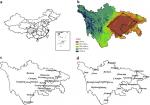Citation:

摘要:
Visibility in the Sichuan Basin of China has long been at low levels due to topographic features and high pollution. This study produced trend maps tracking the spatial patterns and temporal trends of visibility in the Sichuan Basin based on 38 years of daily visibility data. Three major fluctuations in the visibility pattern were found: a period of decreasing visibility from 1973 to 1990, a period in which the visibility pattern remained stable from 1991 to 2000, and a period of the visibility recovery from 2001 to 2010. Data from 12 stations in the Sichuan Basin were further analyzed using cumulative percentiles, ridit analysis and days of visibility > 19 km and < 10 km. Hazy conditions were most prevalent in Chengdu and Chongqing, which had visibility less than 10 km and more than 200 low visibility days per year after 2000. Fengjie, Youyang and Langzhong showed consistent declines in visibility and in the number of days with visibility > 19 km whereas Liangping, Nanchong and Wanyuan experienced relatively small decreases but much variation. Upturn trends were observed in Daxian, Mianyang, Ya'an and Yibin after 1995. Although the specific trends differed among stations, a general trend of reduced visibility was found over Sichuan basin. Median visibilities in 2000s were approximately 4 to 38% lower than those during the 1970s, indicating that more efforts are needed for recovery. This study represents the first comprehensive analysis of long-term visibility patterns in the Sichuan Basin.
